MARIANI’S
November
28,
2010
NEWSLETTER
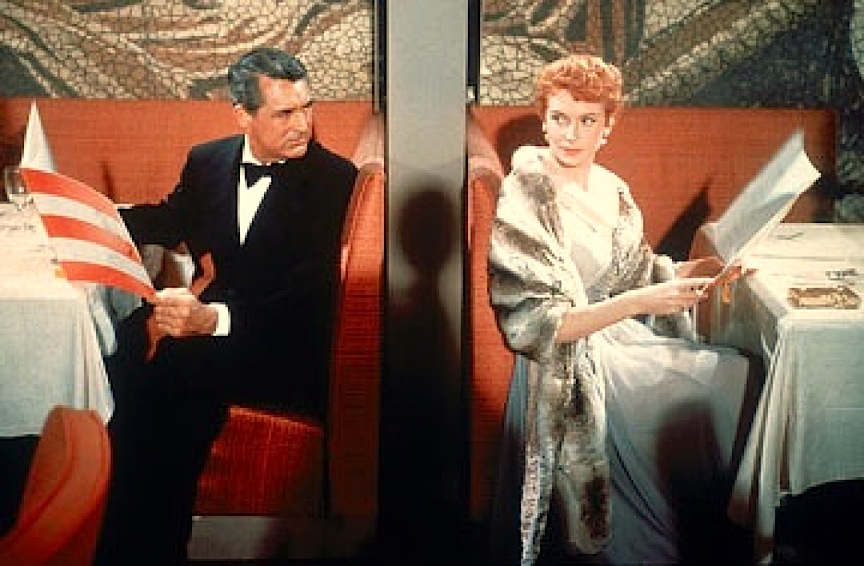
Cary Grant and Deborah Kerr in "An
Affair to Remember" (1957)
~~~~~~~~~~~~~~~~~~~~~~~~~~~~~~~~~~~~~~~~~~~~~~~~~~~~~~~
➔ QUESTIONS? TO REACH JOHN MARIANI
WRITE
TO: newsletter@johnmariani.com.
➔ ARCHIVE: Readers
may now access
an
Archive of all past newsletters--each annotated--dating back to July,
2003, by simply clicking on www.johnmariani.com/archive
➔ SUBSCRIBE AND
UN-SUBSCRIBE: You may subscribe anyone you wish
to this newsletter--free of charge--by
clicking here.
GOOD
NEWS! Esquire.com now
has
a
new
food
section
called
"Eat
Like
a
Man,"
which
will
be
featuring
restaurant
articles
by
John
Mariani
and
others
from
around
the
USA.
THIS WEEK: PAT'S
STEAK
HOUSE,
LOUISVILLE,
KY
~~~~~~~~~~~~~
☛ In
This Issue
POTPOURRI by Rob Mariani,
Suzanne Wright, and Edward Brivio
NEW YORK CORNER: WHEN A
PIZZA'S NOT A PIZZA IT'S A PANUOZZO AT
SAN MATTEO by
John
Mariani
NOTES FROM THE WINE CELLAR: Israeli Wines—So What’s Not to Love? by John Mariani
QUICK BYTES
~~~~~~~~~~~~~
POTPOURRI
by Suzanne
Wright, Edward Brivio and
John Mariani
This week, a
potpourri of short pieces by Virtual
Gourmet's writers on a variety of
good things.
A
WILD
GAME
SUPPER IN VERMONT
By Rob Mariani
For
364
days
of
the year, the little Vermont Town of Bradford chugs sleepily along
in its anonymity, just one of many diminutive, unpretentious New
England
villages along the Connecticut River. Other than some deer hunting and
some
skiing, not too much really happens here. Then, every November
on the Saturday afternoon before Thanksgiving, the cars, the pickup
trucks, the
vans, and the tour buses start showing up in droves at the stately
white
United Church of Christ on Rt. 5, Bradford’s main drag.
It’s the weekend of the infamous Bradford Wild Game Supper. Between the hours of 2:30 pm and 10 pm, traditionally a thousand or more people from nearly every state and several foreign countries appear here to wait patiently in the church pews until their number is called for their seating in the basement.
After several years of ritualistic attendance at The Supper, my buddies and I have come to call it “the beast feast.” None of us quite knows why we drive four hours from Rhode Island to get here. It’s not like you can’t find a good piece of venison where we live. But the Game Supper has become a kind of ceremonial rite with us, just as it has with many others.
Surprisingly, this obscure event has been covered in the New York Times, The Boston Phoenix, Diversion, House & Garden, The Washington Post, Yankee Magazine, Sports Illustrated, the AP and UPI, and many other magazines and papers--not to mention a score of TV shows.
Down
inside the church basement, I'm elbow to elbow with local loggers,
dairy farmers,
politicians, and shade tree auto mechanics; the florescent lighting
instantly
bleaches all ambiance from the place, accentuating every blemish, every
grease
circle, every gravy lump. We cue up in an army chow line and a team of
10 or 12
people plop  dollops of
game onto our plates.
dollops of
game onto our plates.
We start with the venison chili--a nice balance of heat and meat. The buffalo jerky, which looks like a wallet that’s been run over by a tour bus, is not bad, but it sure gets in between your teeth. The bear sausage is surprisingly mild and tender. The shredded moose is watery and tasteless. The grilled venison medallions are mild and not too gamy tasting. The wild boar sausage (always a favorite) is a delicious smoky blend of flavors. The goose with rice is moist and one of the tastier items, as is the moose sausage.
My more intrepid friends who like really gamy meat tell me that the beaver is great again this year. (The off-color jokes that go with it of course, are not always conducive to a great culinary experience.) I tried it one year and have not gone back for seconds.
Church
members
in
rumpled
aprons hover around the tables filling our paper cups with
sweet apple cider and de-caf. Dessert is a square of homemade
gingerbread with
a swirl of hand-whipped cream. A good finish. The whole meal takes
maybe 25
minutes to consume but you’re still digesting it for a good three hours
afterward. And talking about it for the next twelve months.
And
that’s
about it.
Not exactly a religious experience (even though it takes place in a
church).”The
Beast Feast” is over for another year.
For info on next year's supper, call 802-222-4670. Seats are very
limited and the reservation process very strict. Requests
cannot be postmarked BEFORE Oct. 19, but wait much longer and you may
not get a seat. Prices are $25 for adults, $12 for children under 10.
Send a check made out to Bradford United Church of Christ (or BUCC), UCC Wild Game
Supper, P.O. Box 861, Bradford VT 05033, along with a
self-addressed, stamped envelope and a note indicating when you’d like
to eat. Seatings are at one-hour intervals from 2:30-6:30 p.m. (Be sure
to note if you’re willing to eat at any time if your slot is full.)
`````````````````````````````````````````````````````````
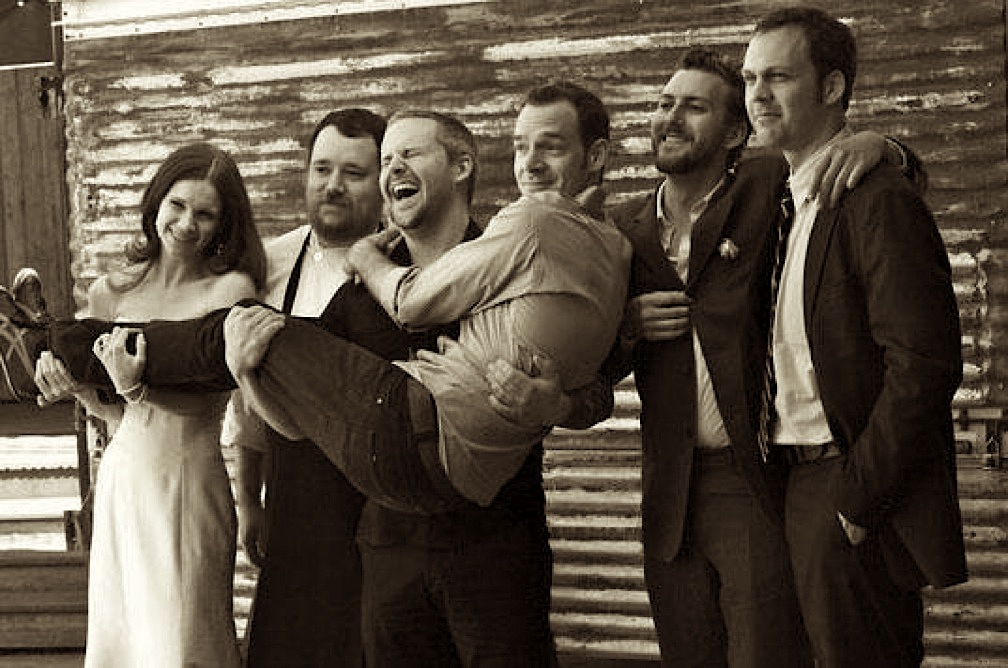 ATLANTA
ATLANTA
"Underground” Supper
Club: The Four Coursemen
By Suzanne
Wright
Photos by Chrissy Reed
Although
I’ve
tried
twice,
I haven’t snagged a
reservation at the French Laundry in Yountville, CA.
So when I discovered an “underground” supper club cleverly
dubbed The
Four Coursemen operating in Athens, Georgia, I had a sense of
guarded optimism. Seats quickly sell out
once an email is
sent and diners RSVP at the appointed hour. Only
28
patrons
are
admitted;
a suggested donation covers
costs.
The
response
window
may
be small and the odds daunting,
but it’s well worth the effort to gain admittance.
Once you are “in,” it’s not nearly such a cloak and dagger
affair. Rather, like the
laid-back college town in which it exists, the Four Coursemen (there
are
actually more than four culinarians and they are not all men involved
in the
concepting, preparation and serving of the multi-course meal) is a
decidedly
genial affair, free of pomp and circumstance. Rather,
there’s
an
unpretentious
earnestness
and enthusiasm
for feeding food lovers that underpins the operation.
The Four Coursemen is a labor of love in its purest sense. “Love, community and occasional profit,” is the phrase that Damien, one of the founders, uses to describe the effort. An infectious cooking camaraderie exists between these great-looking 20- and 30-somethings and the diners gathered with an air of reverence you might expect at a Baptist church.
The
evening
was
made
more endearing because it
was not fettered by typical restaurant trappings. The actual location
of the
meal—a rented shotgun house used for the twice-monthly meals—is not
revealed
unless you make the cut. We
arrived at 7 p.m. on a sultry summer evening, cars lining the road for
a third
of a mile. 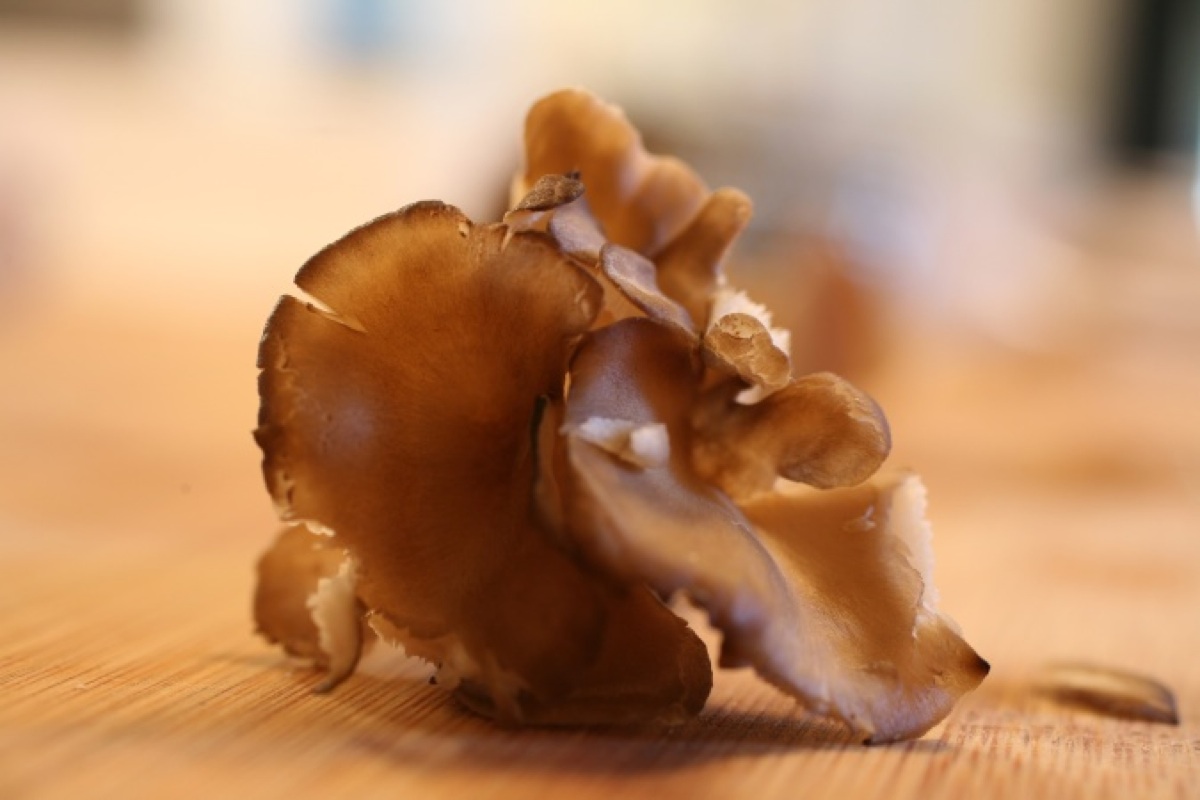 Candles flickered on dark-stained picnic-style
tables; they
burned
out before the food and conversation did. Wine
flowed
during
the
30
minutes or so before we were
seated.
Candles flickered on dark-stained picnic-style
tables; they
burned
out before the food and conversation did. Wine
flowed
during
the
30
minutes or so before we were
seated.
The
charming
woman
sitting
next to me—a
vegetarian—never revealed herself as the mother of Michael Stipe (lead
singer
of Athens’ beloved REM), but my dining companion cleverly pieced
it
together later with the aid of the Google. Many of the other diners in
attendance were students, restaurant workers or affiliated with the
University
of Georgia. Our host, Damien,
praised the conviviality of the group, which chattered easily, bound by
a
shared appreciation of the cuisine. Sommelier,
Nancy,
who
looked
like a fresh-scrubbed 13-year
old, offered
expert, yet down-to-earth advice on pairings.
Athens
is
an
agricultural
area with farms
providing the ingredients for our five-course dinner, which
spotlights seasonal
bounty. In fact, the “friend who
provided the lamb” was in attendance. The first course was a terrific
kickoff:
chilled chicken and chanterelle terrine topped with squash blossoms,
with blueberry mostarda and pickled
green beans cutting the terrine’s richness. A
floral,
faintly
sweet-ish
Pedro
Ximenez Sherry was poured as an
accompaniment. The second course,
a smoked heirloom tomato gazpacho featured
the
heat
of
charred
jalapeños and the
brightness of basil pesto—call
it a bowl of summer. A slightly oaked
Pouilly Fumé was an ideal foil for
the
acidity of the soup. The third
course, while still mighty fine, made less of an impression on my taste
buds: delicate
(under-seasoned?) peekytoe crab atop
corn cakes with grilled
peaches
and pea
shoots. The brown butter,
advertised on the printed menu, somehow was left off the dish and
perhaps it
would have pulled the 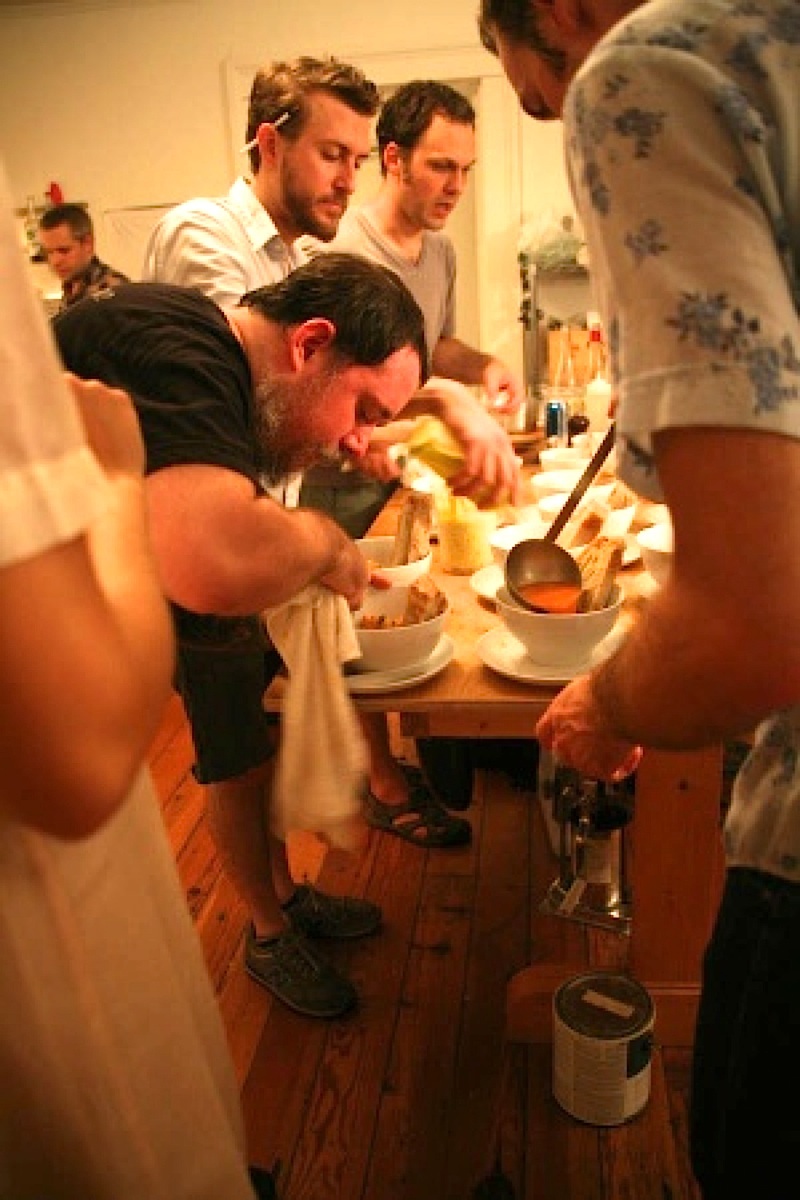 ingredients into focus. Still,
Nancy’s
wine
advice
was so right-on: “pair
fried food with a rosé,” (in this
case, a rosé d’Anjou) that it tempered my slight disappointment.
ingredients into focus. Still,
Nancy’s
wine
advice
was so right-on: “pair
fried food with a rosé,” (in this
case, a rosé d’Anjou) that it tempered my slight disappointment.
The
fourth
course
was
my unabashed
favorite: “cute
lil’
lamb
chop,” as
it was described, served with a roasted sweet and tart cherry tomato
and
raspberry compote, dusted with truffle salt. The
meat,
which
had
a
slight bit of fattiness, benefited
from the surprise of cabbage. A round merlot with a hint of
tannin
perfectly complemented the dish.
The
fifth course was a pull-out-all-the-stops dessert:
milk and cookies
served three ways. Unfortunately,
the heat in the house combined with summer's humidity outside conspired
against the
tangy buttermilk sorbet (which melted quickly) and cat’s tongue cookies
(which
were limp). Still, I give the
chefs points for their moxie; the crowd seemed to dismiss the
weather-related
gaffe, lapping up the ice cream and cookies with gusto.
And the pairing was simply
brilliant: a beer infused with
chocolate and coffee.
The “formal” dinner finally ended around 11 p.m. Then various guests shared their own offerings with the remaining patrons, who seemed hesitant to leave: a wedding gift of patxaran, a Spanish liqueur, and homemade watermelon vodka. There was singing, there was dancing.
“This is ridiculously special,” said the young woman to my right, as we said goodnight at a quarter to midnight.
I couldn’t
have said it better.
Note: During our overnight in Athens, we
stayed at the Foundry Park Inn &
Spa. The rooms are clean if
unremarkable,
but the low-key Southern hospitality, combined with a hydrating massage
scored
points during our short stay.
``````````
NEW
YORK: The Relais &
Châteaux Cookbook
by Edward Brivio
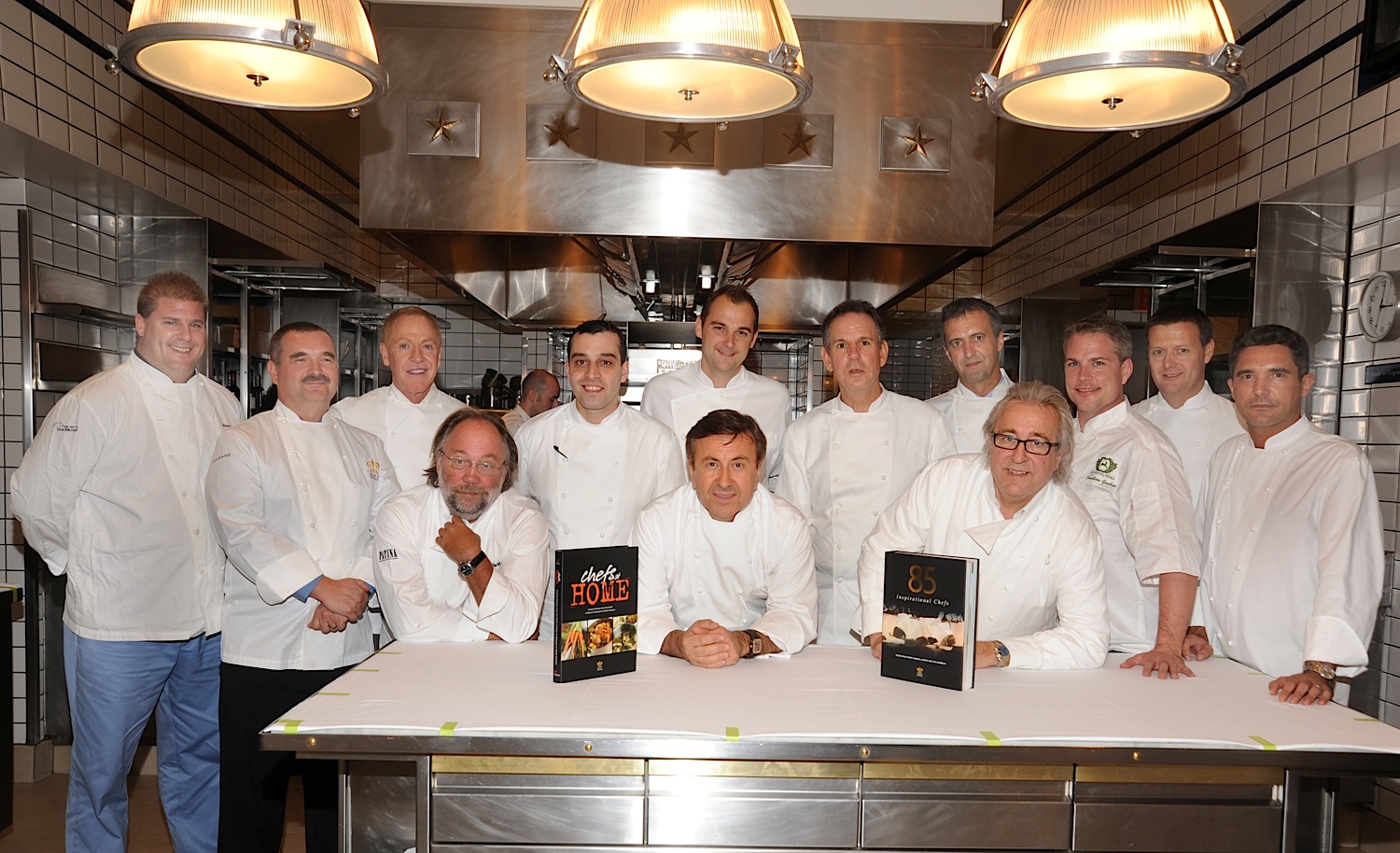
“Haute cuisine dead?” Not if Thomas
Keller and his équipe at Per Se have anything
to say about
it.
A recent
press lunch at the restaurant in the
beautiful Time-Warner building celebrated the publication of the new Relais
& Châteaux Cookbook. For the first time, all 85 of its
chefs in North
America collaborated on a cookbook. Beautifully presented and
very delicious, the meal was a good “trailer” for the book
itself,
defining just what contemporary haute cuisine is all about:
sourcing the very best ingredients, as much as
possible locally, minimal manipulation in the kitchen, maximum
attention given
to every detail of the dish, the unexpected here and there, and
inspired, and
original, yet still appetizing presentations.
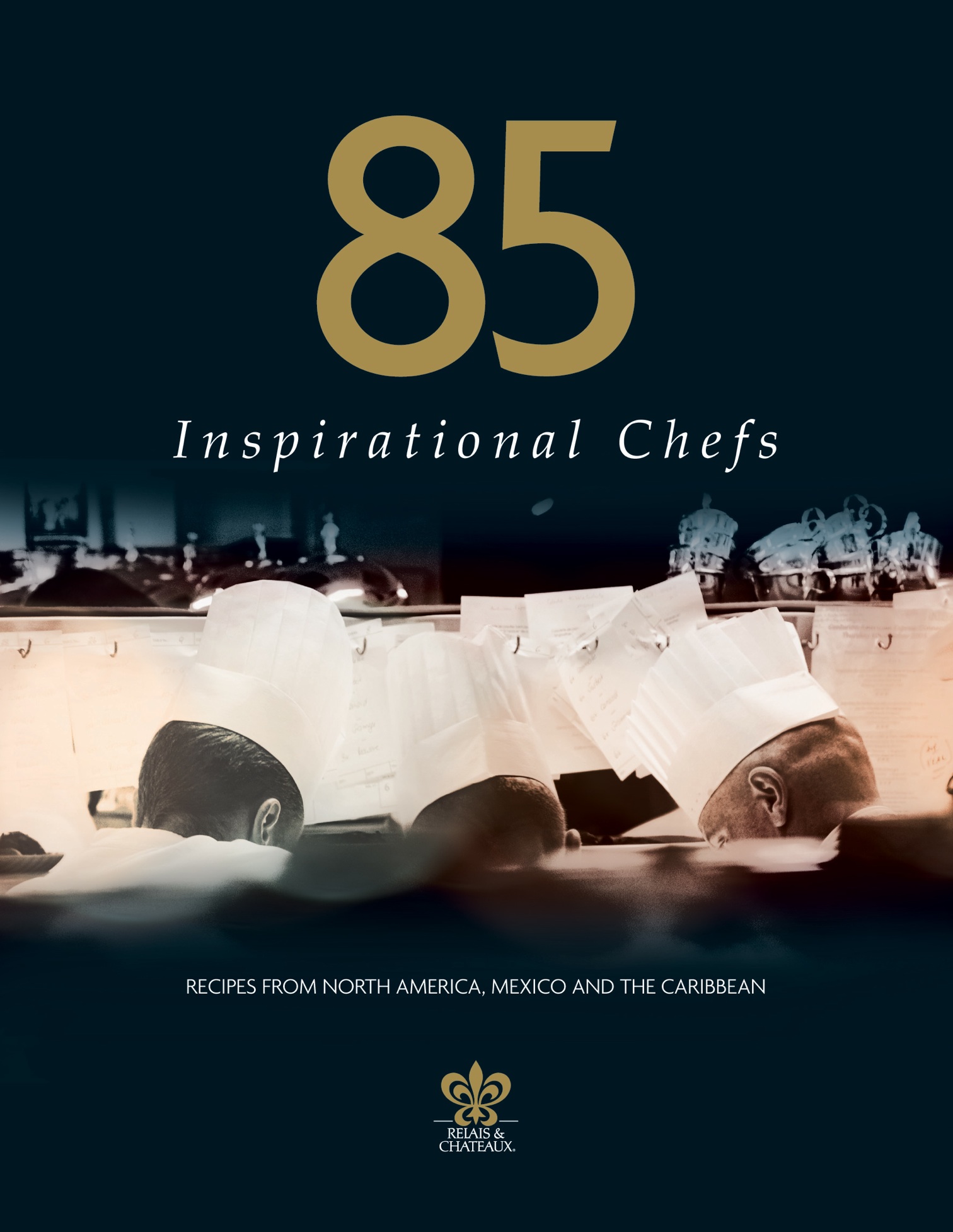 The cookbook is actually two
volumes, the first 85 Inspirational Chefs showcases recipes for
Relais
& Châteaux chefs’ signature restaurant dishes, while in the
second, Chefs
at Home, you’ll find recipes for what the chefs might make for the
“family”
on their rare night off. The set is more than just a beautiful
artifact
testifying to R&C’s pride in having 85 top chefs on its roster,
many, the
absolute best in their field. True, some of the recipes are
for such masterworks --involving so many steps, or an arcane ingredient
or
two-- that they will be tried only by the most adept and intrepid home
cook.
For most of us, such recipes are, simply, “the stuff that dreams are
made of.”
They’re responsible for that little question mark always nagging at the
back of
any good cook or chef’s mind.
The cookbook is actually two
volumes, the first 85 Inspirational Chefs showcases recipes for
Relais
& Châteaux chefs’ signature restaurant dishes, while in the
second, Chefs
at Home, you’ll find recipes for what the chefs might make for the
“family”
on their rare night off. The set is more than just a beautiful
artifact
testifying to R&C’s pride in having 85 top chefs on its roster,
many, the
absolute best in their field. True, some of the recipes are
for such masterworks --involving so many steps, or an arcane ingredient
or
two-- that they will be tried only by the most adept and intrepid home
cook.
For most of us, such recipes are, simply, “the stuff that dreams are
made of.”
They’re responsible for that little question mark always nagging at the
back of
any good cook or chef’s mind.
Lavishly illustrated --if the photo of snow-covered Glendorn Inn on of 85 doesn’t give you wanderlust, or the glossy image of chef Christopher Brooks Slow-Roasted Pork in Chefs at Home, inspire you to get up and cook, nothing ever will-- beautifully bound, coffee-table sized, and slip-cased to boot, this is a much better “working” cookbook than any this opulent would lead one to believe. Well laid out, with gorgeous full-page pictures of the properties and of the finished dishes, the volumes also sit flat without damage to the binding (no matter what page you‘ve opened it to), that is, if you can find the 18 inches of spare counter space it requires.
If
you’ve
ever
wondered
just what went into or
how to achieve the look of those elaborate creations served at some of
North
America, Canada, Mexico and the Caribbean’s finest eateries, all the
intricate
details and little secrets are laid out for you here. For the most
part, these
are exquisite set pieces, dramatic enough --some very High Drama
indeed-- for very special occasions, or for
anytime you want to turn a meal into a feast. Certainly, Maine lobster
with sweet pea puree, potato fondant, and a vanilla-grapefruit beurre
blanc,
from chef Jason Robinson of the Inn at Dos Brisas, in Washington,
TX, the Pan-seared Sea Scallop with caramelized endive, leek
puree, and shaved
black truffle (optional) by chef Patrick O‘Connell from the Inn at
Little
Washington, or the Lemon Meringue cake by Claire Chapman, pastry chef
at
the Planters Inn in Charleston are ambitious, elaborate labors of love,
designed to be the highlight of any personal or family gala, no matter
how
grand, or contrived to win the gratitude and perhaps the heart of a
diffident significant other. Even in the full-blown, haute cuisine
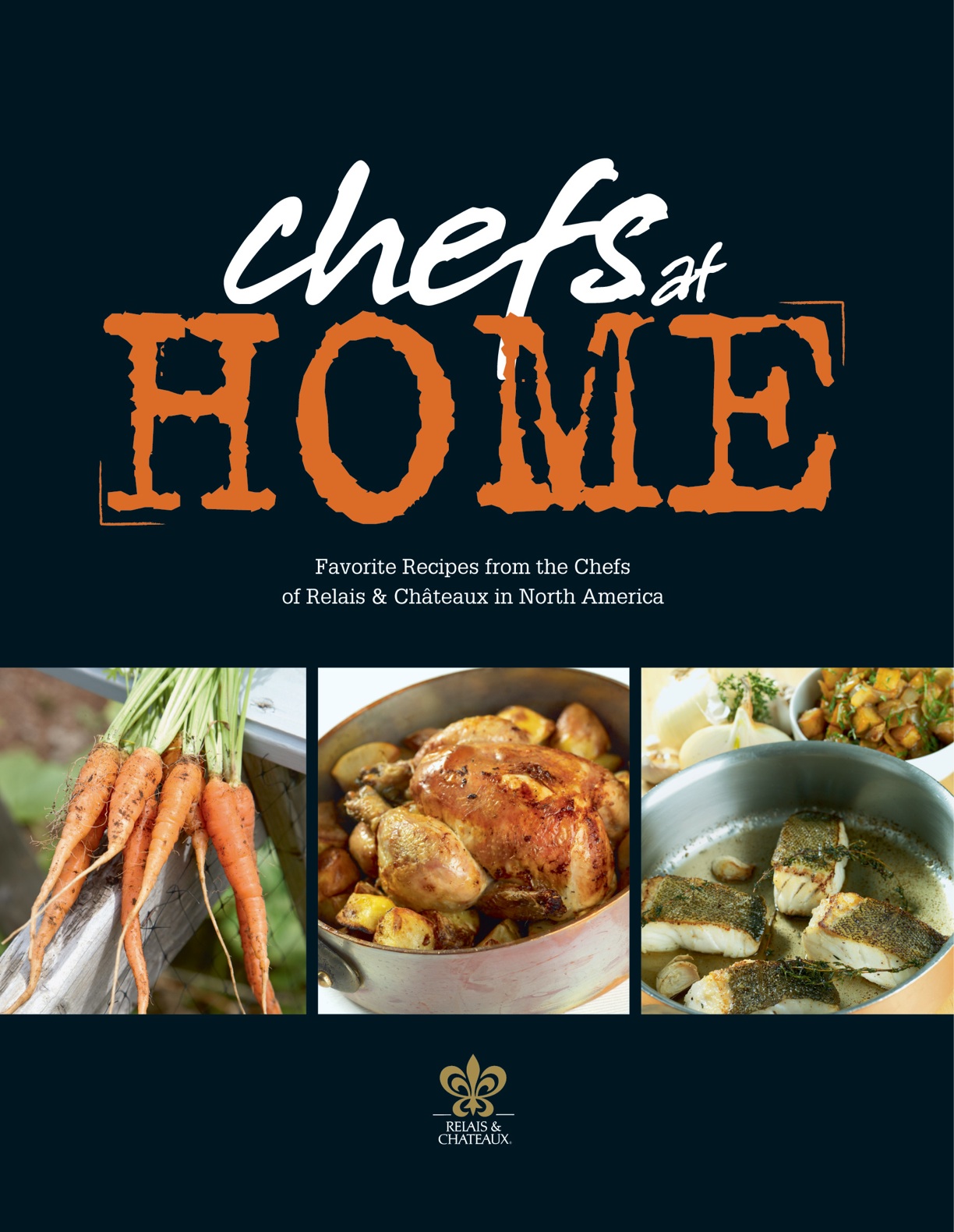 extravaganzas there are a elements: purees, fondants,
coulis,
emulsions,
vinaigrettes, etc. that are
easily prepared and could be used regularly to liven
up the nightly meal.
extravaganzas there are a elements: purees, fondants,
coulis,
emulsions,
vinaigrettes, etc. that are
easily prepared and could be used regularly to liven
up the nightly meal.
Years of hard, occasionally Herculean, work on the part of the chefs, led to the mastery needed to put together these, their most imaginative creations, and here in clear, highly legible recipes, they are laid-out, step by step --albeit often quite a few steps--for anyone who takes the time to read through and then follow the recipes.
The Chefs at Home volume, on the other hand, just as its name suggests, gives you less complex recipes, more or less easily doable, but refined through the inspiration of some of the best chefs around. Butternut squash soup, Slow-roasted Pork, Falafel, Pappardelle alla Bolognese, or White Chocolate and Coconut Mousse are all recipes that are quickly and conveniently prepared, and anyone who screws up Jean-George Vongerichten’s delicious Roast chicken with potatoes should perhaps just avoid kitchens altogether. Ditto for the Olive Oil cake of 85, which is, besides, a great little addition to any cook’s repertoire. (Although, Jean-George must have access to chickens with a lot less fat that what’s available to the average consumer, for unlike him, at least according to the instructions given, I had to drain the roasting pan a few times to keep the potatoes from swimming in grease. And while we‘re on the subject, don’t the sweetbreads in the recipe on page 118 need the usual, requisite, preliminary handling clearly outlined in the recipe on page 168?)
So let these elegant volumes grace your coffee table or book shelf, but remember they’re for more than just vicarious pleasure, and do occasionally expose them to the “heat” --and spatters--of the kitchen.
Published by Network
Publishing Ltd, UK, and available at www.relaischateaux.com,
or www.yeschefmagazine.com
:$60 for
85 Inspirational Chefs, $30 for Chefs at Home, and $90
for
the Set.
`````````````````````````````````````````````````````````````
NEW YORK CORNER
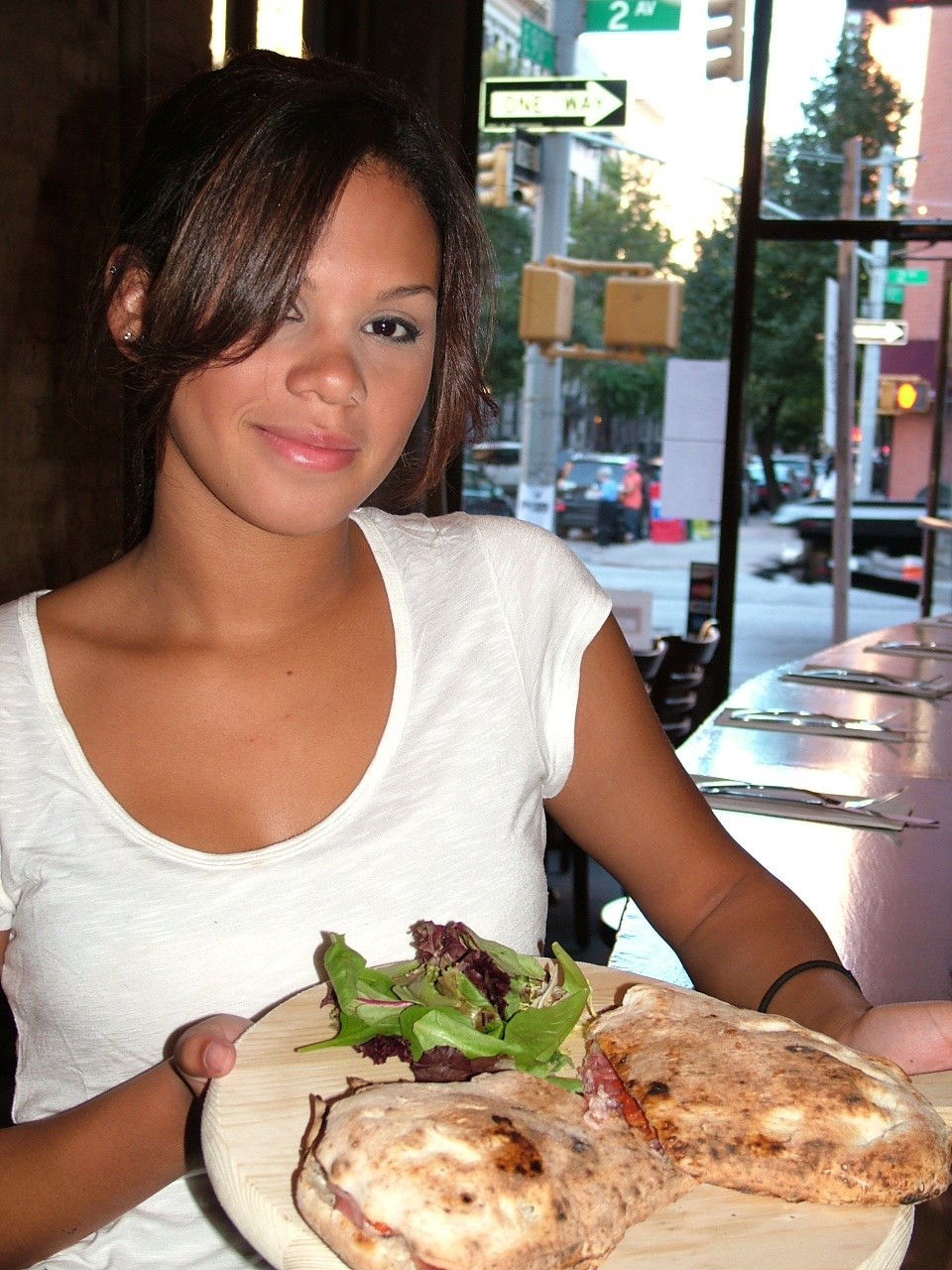 WHEN A
PIZZA'S
WHEN A
PIZZA'S
NOT A PIZZA,
IT'S A PANUOZZO
AT NYC'S SAN
MATTEO
by
John Mariani
The
pizza
mania
that has gripped cities
like New York, Los Angeles, and San Francisco, exalting the once humble
Neapolitan pie to the culinary sublime is sure to ebb sooner rather
than later, and the debates will, I hope, cease as to who makes the
best. It is refreshing, then, to find a good new pizzeria that has its
own twist to things. NYC's new San
Matteo
(212-426-6943), located at 1739 Second Avenue at
90th Street--not a neighborhood with great pizza options--is unique, I
believe, for serving a panuozzo
(left).
According to the owners of San Matteo, it's really only familiar to
those who live within a few
towns in the Salerno region of Campania, like Gragnano and
Agerola,
which draw people there just to eat the hot, soft pizza-like items. "The panuozzo
starts as would a pizza," they say, "raw, fresh,
well-raised dough, wonderfully springy and with all the right levels of
different flours and seasonings. Once an order has been placed, a
small
amount of dough is lopped off, stretched and filled with a
variety of items.
The dough forms a pocket and it is quickly baked in a wood-burning
oven. 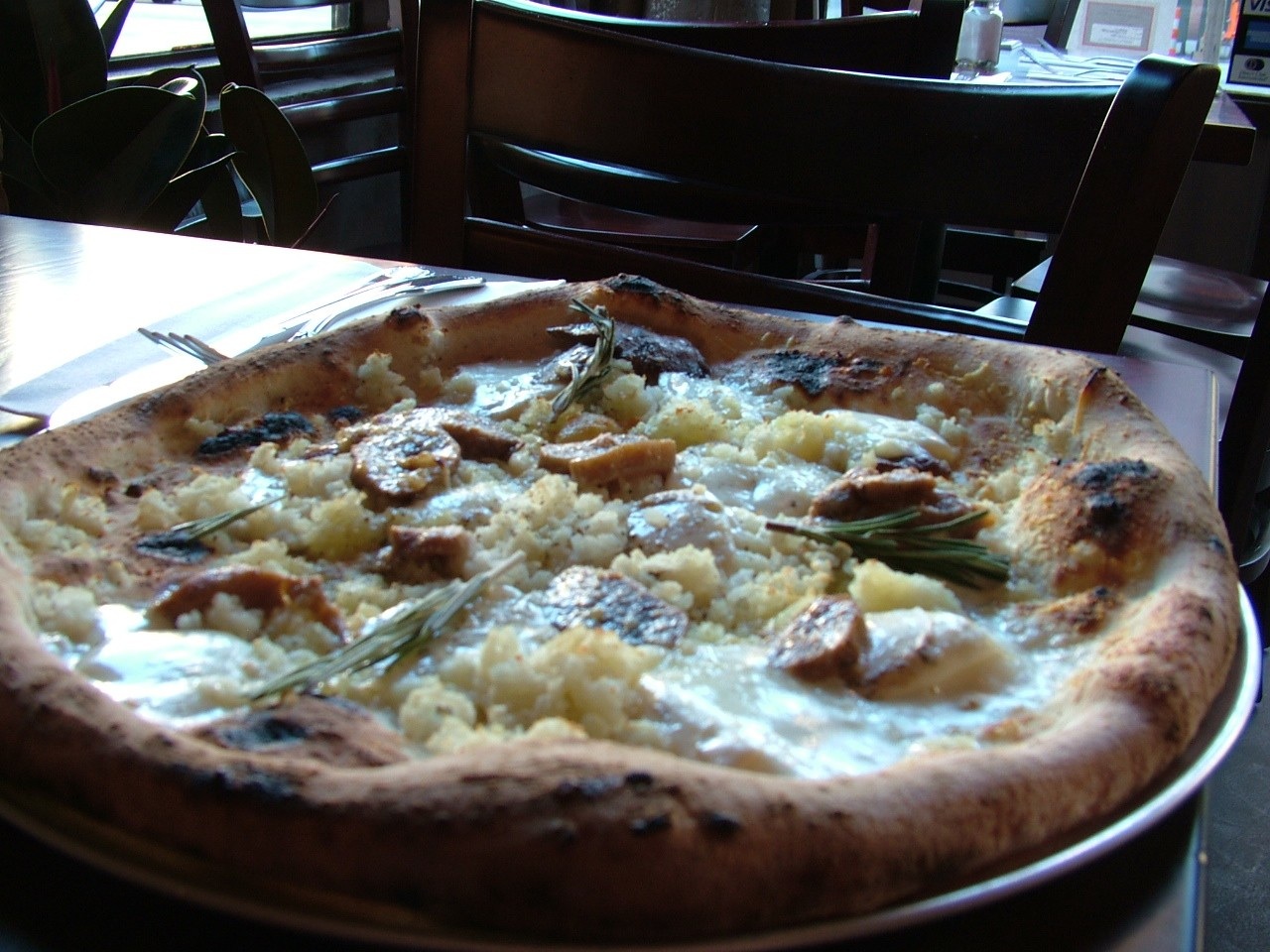 The result is a type of panino
but with freshly baked bread.
The bread, with its beautiful honeycomb-like crumbs, is moist and
permeated
with the scent of smoked scamorza or the sweetness of porchetta,
just
to
name
but
a
few of the ingredients that can be had."
The result is a type of panino
but with freshly baked bread.
The bread, with its beautiful honeycomb-like crumbs, is moist and
permeated
with the scent of smoked scamorza or the sweetness of porchetta,
just
to
name
but
a
few of the ingredients that can be had."
There
is
also mortadella,
eggplant, escarole,
anchovies, buffalo
mozzarella, buffalo ricotta, soppressata,
pecorino romano, and
much more. The pizzaiolo and
partner is Giuseppe Paciullo, who came from the well-known Zero Otto Nove in
the Bronx. His cousin, Fabio Casella, worked for years at the equally
famous Mike’s Deli on
Arthur
Avenue, while their partner Vicenzo Scardino built the
pizza oven for the narrow little corner eatery.
In
addition
to
the
panuozzi, there are 15
Neapolitan-style pies ($11-$16) with
terrific crust, just the right height, crispiness, and chewiness,
and
the variety of toppings are very Italian (not Californian or New Wave
New
York), like chiodini mushrooms,
soppressata, prosciutto,
potato (above) and Speck bacon, all
seasoned with good herbs and tomato. The owners order from the best
ingredient
suppliers from here and Italy, including Alps Provision in Queens for
charcuterie; flour from Antonio Amato, Salerno, olive oil from Colline
Salernitane, and Italian canned tuna.
You can begin with a good-sized platter
of Italian charcuterie and cheeses, and, to end off the evening, there
is a pizza with the rich, luscious Nutella hazelnut-chocolate
spread, no longer a novelty but still irresistible. Also, don't
miss the caffé
crema, like granita with
cream.
So, San Matteo is not your typical New York pizzeria,
though these days there are hardly any that are. But San
Matteo's owners' commitment to authenticity, honest cooking, and
the best ingredients show throughout the menu, and the introduction of
the panuozzo to NYC food
culture can only be a real good thing.
San
Matteo is open for Breakfast, Lunch and Dinner, daily
~~~~~~~~~~~~~~~~~~~~~~~~~~

MAN ABOUT TOWN
by
Christopher Mariani
JW MARRIOTT MARQUIS Grabs DB Bistro Moderne, Miami
45 Avenue of the Americas
Miami,
FL
305-4521-8600
JW
Marriott
Marquis
Hotel
Two weeks ago I was in Florida, quickly becoming one of my favorite states, for the third time in two months, staying in Miami to check out the brand new JW Marriott Marquis Hotel. My biggest attraction to the hotel was the presence of master chef Daniel Boulud’s latest restaurant, DB Bistro Moderne, but I was also enticed by the opportunity to meet the entire Miami Heat basketball team at their Tip-Off event, along with many other celebrities for a charity event held during the hotel’s grand opening celebrations.
 The
JW Marriott Marquis looks to be a project that will have
a dominant presence in the downtown Miami hotel scene, only 15
minutes
from Miami International Airport. I entered my room on the 22nd
floor and was instantly impressed with the view overlooking the
downtown
bay area; of course it helped that it was a perfectly sunny day. The standard guest rooms have a very
open feel to them, largely because
of the room’s floor to ceiling windows, and the higher the
floor the better the view. The rooms are
simple in design yet extremely high end, obviously owing to the
Marquis brand's influence
in terms of quality. The amenities
are typical of a deluxe property, with free internet and
business friendly
services, which nowadays better
exist without question when claiming to be a
premiere hotel; also worth a mention, the 52-inch plasma television.
The
JW Marriott Marquis looks to be a project that will have
a dominant presence in the downtown Miami hotel scene, only 15
minutes
from Miami International Airport. I entered my room on the 22nd
floor and was instantly impressed with the view overlooking the
downtown
bay area; of course it helped that it was a perfectly sunny day. The standard guest rooms have a very
open feel to them, largely because
of the room’s floor to ceiling windows, and the higher the
floor the better the view. The rooms are
simple in design yet extremely high end, obviously owing to the
Marquis brand's influence
in terms of quality. The amenities
are typical of a deluxe property, with free internet and
business friendly
services, which nowadays better
exist without question when claiming to be a
premiere hotel; also worth a mention, the 52-inch plasma television.
Throughout the night, as the drinks were served in excess, the Heat players split up into the hotel’s multiple
 entertainment rooms where they
casually played Wii bowling,
pool and hit
golf balls into a simulation driving range screen, quite an
entertaining
spectacle to watch a seven-footer swing a driver, I must say. Just for the record, it turned out that I am a
better
bowler than Lebron James and a better putter than Dwayne Wade, possibly
because
the hotel clubs were not exactly built for 6-foot-4 basketball players
who appear
like giants when playing with what look like children’s putters;
regardless, I did
beat two of the world’s most high profile athletes in a sports
competition.
entertainment rooms where they
casually played Wii bowling,
pool and hit
golf balls into a simulation driving range screen, quite an
entertaining
spectacle to watch a seven-footer swing a driver, I must say. Just for the record, it turned out that I am a
better
bowler than Lebron James and a better putter than Dwayne Wade, possibly
because
the hotel clubs were not exactly built for 6-foot-4 basketball players
who appear
like giants when playing with what look like children’s putters;
regardless, I did
beat two of the world’s most high profile athletes in a sports
competition.
The
following
evening
I was invited to the hotel’s charity event, where NBA legend Tim
Hardaway, Yankee star Alex Rodriguez, tennis title winners Ana
Kournikova and
Venus Williams, and the beautiful Brooke Shields were all in attendance. Shamelessly, I attempted to hit on Ana
Kournikova after a few Grey Goose vodkas on the rocks, which did not
exactly go
to well but at least I can sleep at night knowing I tried.
After
a
long
night at the charity event,
I had the luxury of sitting just one table from Brooke
Shields at one of the hotel’s restaurants, ThreeFortyFive.
After that pleasant breakfast, I sat down with chef Daniel
Boulud to discuss his vision
 behind the
new DB Bistro Moderne, a branch of the original in
Manhattan's Theater District. I am not one
to grill a chef (no pun intended) as some
journalists lunge
at the opportunity to do, because I would rather let the chef speak
through his
or her food. But a question that always enters my mind when a chef
opens
multiple restaurants in different locations is, how do you sustain the
same
quality of food and service at restaurants you cannot physically be at
all the
time? Boulud stated very clearly that, no,
he cannot be at all of his restaurants, even though he
would like to be, but it’s all about having the right people in place. Besides some of the service staff and
line cooks working at the restaurant, all of the top chef positions
and front-of-the-house managers at DB Bistro have all previously worked
at one, if not
more, of his restaurants. For instance,
general manager German Alvarado has worked with Boulud for over 12
years at
Daniel, Café Boulud and Bar Boulud, all in NYC, so it is
evident he knows what is
expected. Executive chef Jarrod
Verbiak (left, with Boulud)
had worked under Boulud for many years upon his graduation
from
the Culinary Institute of America in 2002, working at Daniel, Daniel
Boulud
Brasserie in Las Vegas, Café Boulud in Palm Beach, and most
recently at Maison
Boulud in Beijing. I was also
happy to hear that Boulud feels Miami has been ready for his
type of
cuisine for many years now, a city that some critics have denied
culinary
praise. After the interview I
went off with great anticipation for my dinner that evening at
DB.
behind the
new DB Bistro Moderne, a branch of the original in
Manhattan's Theater District. I am not one
to grill a chef (no pun intended) as some
journalists lunge
at the opportunity to do, because I would rather let the chef speak
through his
or her food. But a question that always enters my mind when a chef
opens
multiple restaurants in different locations is, how do you sustain the
same
quality of food and service at restaurants you cannot physically be at
all the
time? Boulud stated very clearly that, no,
he cannot be at all of his restaurants, even though he
would like to be, but it’s all about having the right people in place. Besides some of the service staff and
line cooks working at the restaurant, all of the top chef positions
and front-of-the-house managers at DB Bistro have all previously worked
at one, if not
more, of his restaurants. For instance,
general manager German Alvarado has worked with Boulud for over 12
years at
Daniel, Café Boulud and Bar Boulud, all in NYC, so it is
evident he knows what is
expected. Executive chef Jarrod
Verbiak (left, with Boulud)
had worked under Boulud for many years upon his graduation
from
the Culinary Institute of America in 2002, working at Daniel, Daniel
Boulud
Brasserie in Las Vegas, Café Boulud in Palm Beach, and most
recently at Maison
Boulud in Beijing. I was also
happy to hear that Boulud feels Miami has been ready for his
type of
cuisine for many years now, a city that some critics have denied
culinary
praise. After the interview I
went off with great anticipation for my dinner that evening at
DB.
The
restaurant
is located just off to the side of the hotel’s lobby and is grand in
every
sense of the word. The bar area is
almost the size of the actual restaurant, filled with giant lounge
chairs,
sleek lines, dark grey coloring, and a sunken polished black bar that
stretches
the length of the room. The
restaurant itself (right) is split
into three rooms where guests dine within a
very chic and elegant atmosphere surrounded by washed oak floors and
walls. Chef Boulud began the
evening with a rich ballotine de caille
et foie gras en crôute served with Brussels sprouts, porcini confit, and
sweet raisins adding a wonderful balance of flavor to the dish. For our mid-course we were served a flavorful
grouper tagine Mediterranean-style, surrounded by
braised
peppers, chickpea panisse and a
refreshing hint of cilantro.
(right) is split
into three rooms where guests dine within a
very chic and elegant atmosphere surrounded by washed oak floors and
walls. Chef Boulud began the
evening with a rich ballotine de caille
et foie gras en crôute served with Brussels sprouts, porcini confit, and
sweet raisins adding a wonderful balance of flavor to the dish. For our mid-course we were served a flavorful
grouper tagine Mediterranean-style, surrounded by
braised
peppers, chickpea panisse and a
refreshing hint of cilantro.
The
main course was a direct reflection of chef Boulud’s classic style, the
boeuf aux carottes, a roasted tenderloin
sided by a hearty oxtail ragoût. Dessert
was
a terrific, quite traditional French golden pineapple Tatin,
dotted
with raisins and lavished with rum
ice
cream. Although this may have only
been a preview dinner before the actual opening just days later, it
was a
clear indication that Boulud is serious about having one of the
finest restaurants in Miami, where French cuisine is not easy to
find. As Boulud said, Miami is quickly
becoming a very food savvy city, and I foresee DB Bistro
will be a superb addition to the thriving gastronomy of Miami.
To contact Christopher Mariani send an email to christopher@johnmariani.com
``````````````````````````````````````````````````````````````````````````
NOTES FROM THE WINE CELLAR
Israeli Wines—So What’s Not to Love?
by John Mariani
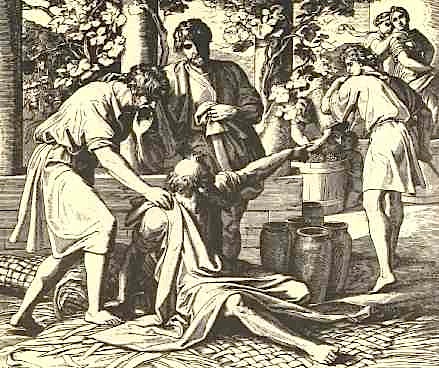 A decade ago I
would never
have written a sentence like, “On a recent trip to Israel I was very
enthusiastic to order Israeli wines with my meals.” For despite the
biblical
claim (Psalms 104:15) that wine was a gift of God “to gladden
the heart
of man,” at least two millennia went by before truly good wine came out
of
Israel. Indeed, when the fourth edition of The Sotheby’s Wine
Encyclopedia
appeared in 2005, Israeli wines received only one skimpy paragraph.
A decade ago I
would never
have written a sentence like, “On a recent trip to Israel I was very
enthusiastic to order Israeli wines with my meals.” For despite the
biblical
claim (Psalms 104:15) that wine was a gift of God “to gladden
the heart
of man,” at least two millennia went by before truly good wine came out
of
Israel. Indeed, when the fourth edition of The Sotheby’s Wine
Encyclopedia
appeared in 2005, Israeli wines received only one skimpy paragraph.
But there I was this autumn eating “Jacob & Esau’s biblical red lentil stew” and a wild mallow herb called hubeiza “eaten during the ’48 siege on Jerusalem” as part of the “King David’s Feast” at one of Jerusalem’s finest restaurant, The Eucalyptus, happily drinking a 2009 merlot from the Samson Hills made by the Efrat Winery, which started making wines in a Jerusalem alleyway back in 18970, now a leading wine company making more than 100 wines and grape juices.
Noah
ties
one
on after 40 days and nights at sea (Gen.
9:18-29)
A day later at the very modern non-kosher restaurant named Segev, located in Tel Aviv’s business district (Microsoft’s new skyscraper is right across the street), I feasted on grilled duck breast with sunflower seeds and ground sesame, and fresh shrimp cooked in butter and green garlic along with a wonderful bottle of Yarden 2007 Katzrin Chardonnay that I’d swear was right out of Napa Valley; it’s actually from the volcanic soil of the Golan Heights.
In
636
A.D. the Muslims conquered Jerusalem and
ripped out the vineyards, restored in the Twelfth century by the
Crusaders. During the Diaspora the vineyards were abandoned, but upon
the Jews’
return to the Holy Land in the nineteenth century, Baron Edmond de
Rothschild
of France replanted vineyards with European varietals and founded Carmel Winery, and Jewish
vintners have continued to make
wine, both kosher and non-kosher, ever since. Today Israel now has more
than
120 wineries producing wines made from cabernet sauvignon, merlot,
sauvignon
blanc, semillon, 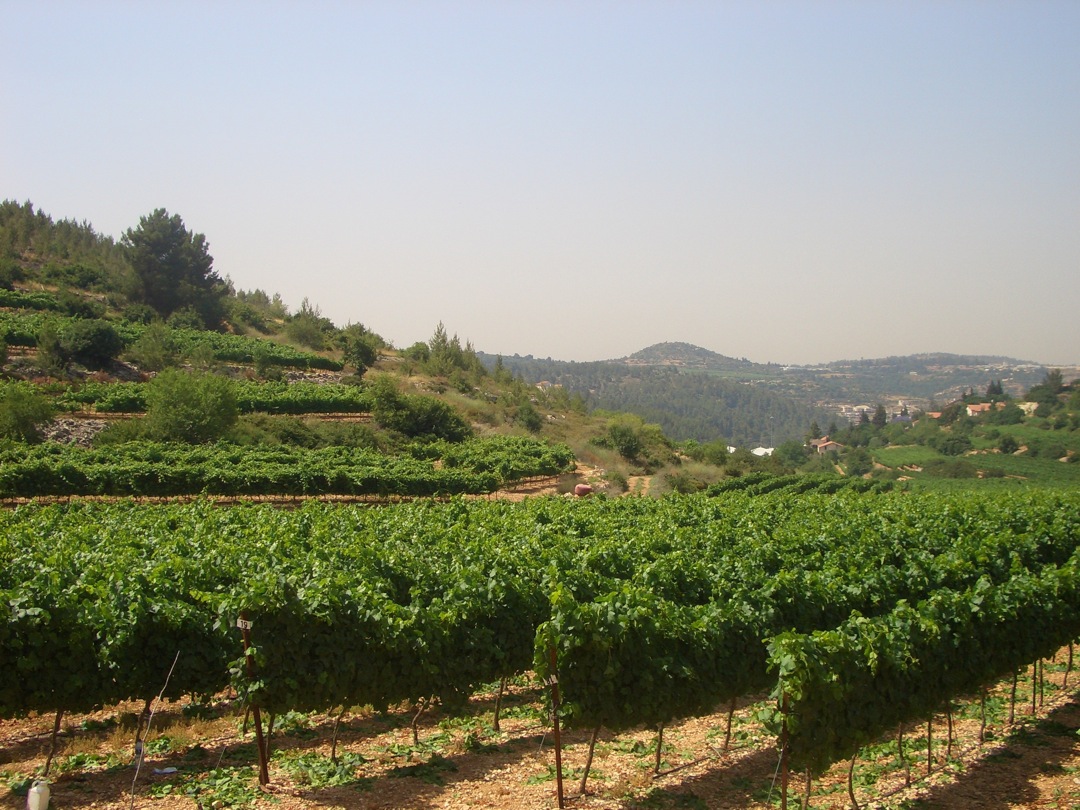 grenache and other varietals.
grenache and other varietals.
Overwhelmingly, Israeli wines are made by cooperatives, with 50 percent made by Carmel; the other big players are Barkan Wine Cellars (vineyards shown right) and Golan Heights Winery. The U.S. is the biggest export market.
Kosher wines still must meet stringent requirements, e.g., no wine may be made before the vine is four years old; vineyards within biblical lands must be left fallow every seven years; only vines may be planted in the vineyard land; and the grapes, after arrival at the winery, may only be handled by certified “Sabbath-observant Jews” using approved materials. Non-Jews may not even handle kosher wines unless they’ve been flash pasteurized (a process called mevushal).
Few kosher wines, however, taste anything like the cloyingly sweet Manischewitz that some American Jews still serve on holidays. The wines I tasted in Israel and many more for the purposes of this report were all clean, well-made, and dry. They can also compete with good wines now coming out of Lebanon, Eastern Europe, Spain and Portugal.
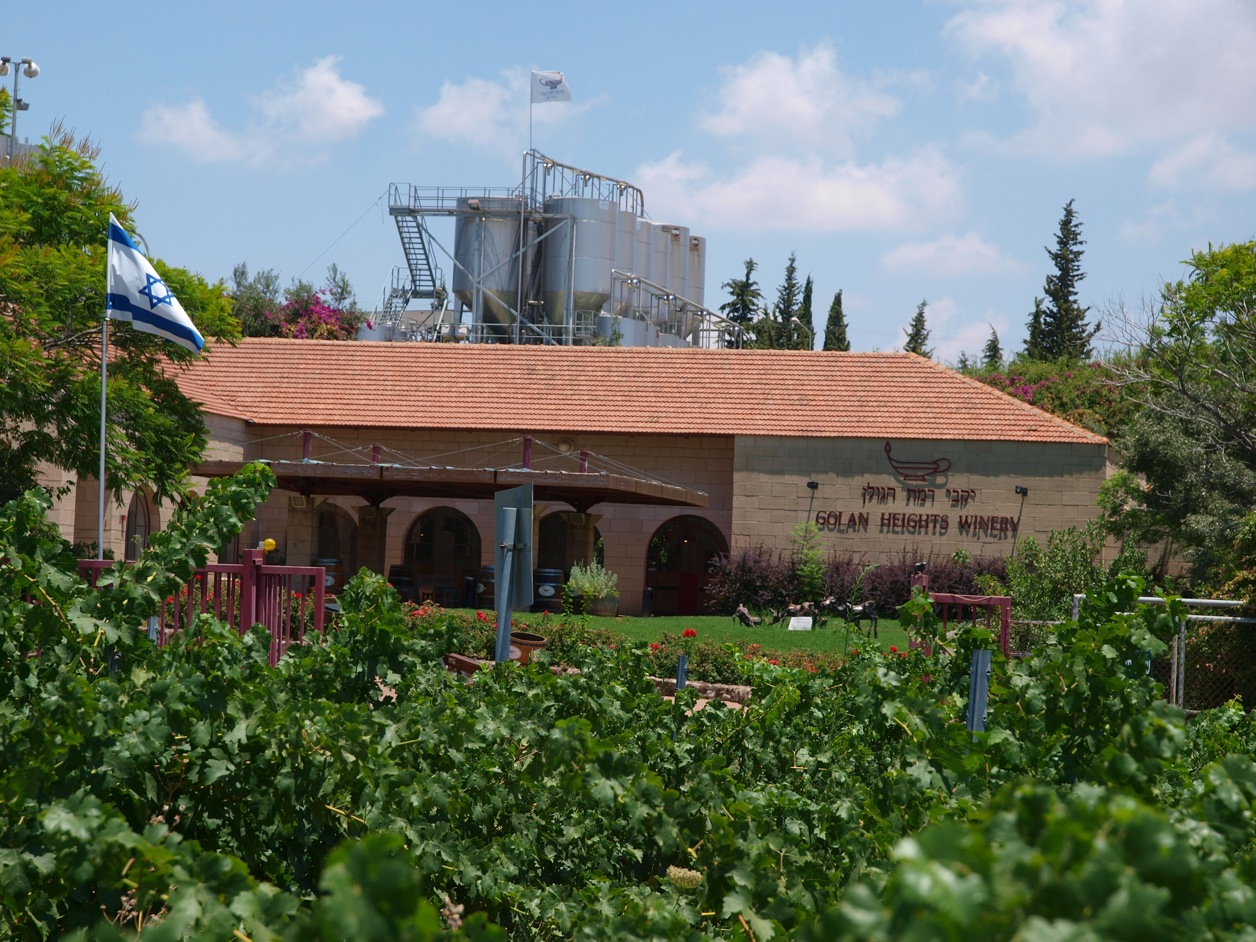 In my
tastings back home I concentrated on red wines, which seemed to offer
more
distinctive varietal character. Some of the cabernet sauvignons
had an
assembly line style about them, with no suggestion of terroir beyond
being
heavy and dense. I preferred the regular cab made by Recanati 2009 ($16), in Upper
Galilee, to
their intensely inky Special Reserve 2006 ($45). The former was an
excellent
young cab, with a high 14.5 percent alcohol but none of the burn of
similar
California examples.
In my
tastings back home I concentrated on red wines, which seemed to offer
more
distinctive varietal character. Some of the cabernet sauvignons
had an
assembly line style about them, with no suggestion of terroir beyond
being
heavy and dense. I preferred the regular cab made by Recanati 2009 ($16), in Upper
Galilee, to
their intensely inky Special Reserve 2006 ($45). The former was an
excellent
young cab, with a high 14.5 percent alcohol but none of the burn of
similar
California examples.
I did enjoy the 2007 Reserve from Bazelet HaGolan ($40), unfiltered and aged for 20 months, which seemed to ameliorate its high 14.9 percent alcohol level, making this a creamy cab. The more modest 13.8 percent of a 2007 Barkan Altitude Series “+720” ($33) brought out its lush fruit, and its medium body goes very well with lamb chops. A very pricey 2006 cab and petit verdot blend by Yatir ($56), a highly regarded vintner in the Judean Hills, had a peppery component that would enhance Middle Eastern-style mezes. The surprisingly named Domaine du Castel Grand Vin 2007 Haute Judee ($76) was a Bordeaux-style blend I found had a rubbery nose, big tannins, and little pleasure about it.
Tishbi
is also among Israel’s star
boutique wineries, dating back to 1882, run since 1984 by Jonathan
Tishbi. Their
wines show careful attention to terroir, blending and aging, and I was
impressed by their 2006 Estate Merlot, with 5 percent cabernet franc
($17). I
would hardly identify Tishbi’s 2006 Estate Pinot Noir ($20) as a pinot
noir in
a blind tasting, for that fickle grape has many expressions. Theirs is
pleasant, well-fruited example, easy enough to drink with any kind of
meat.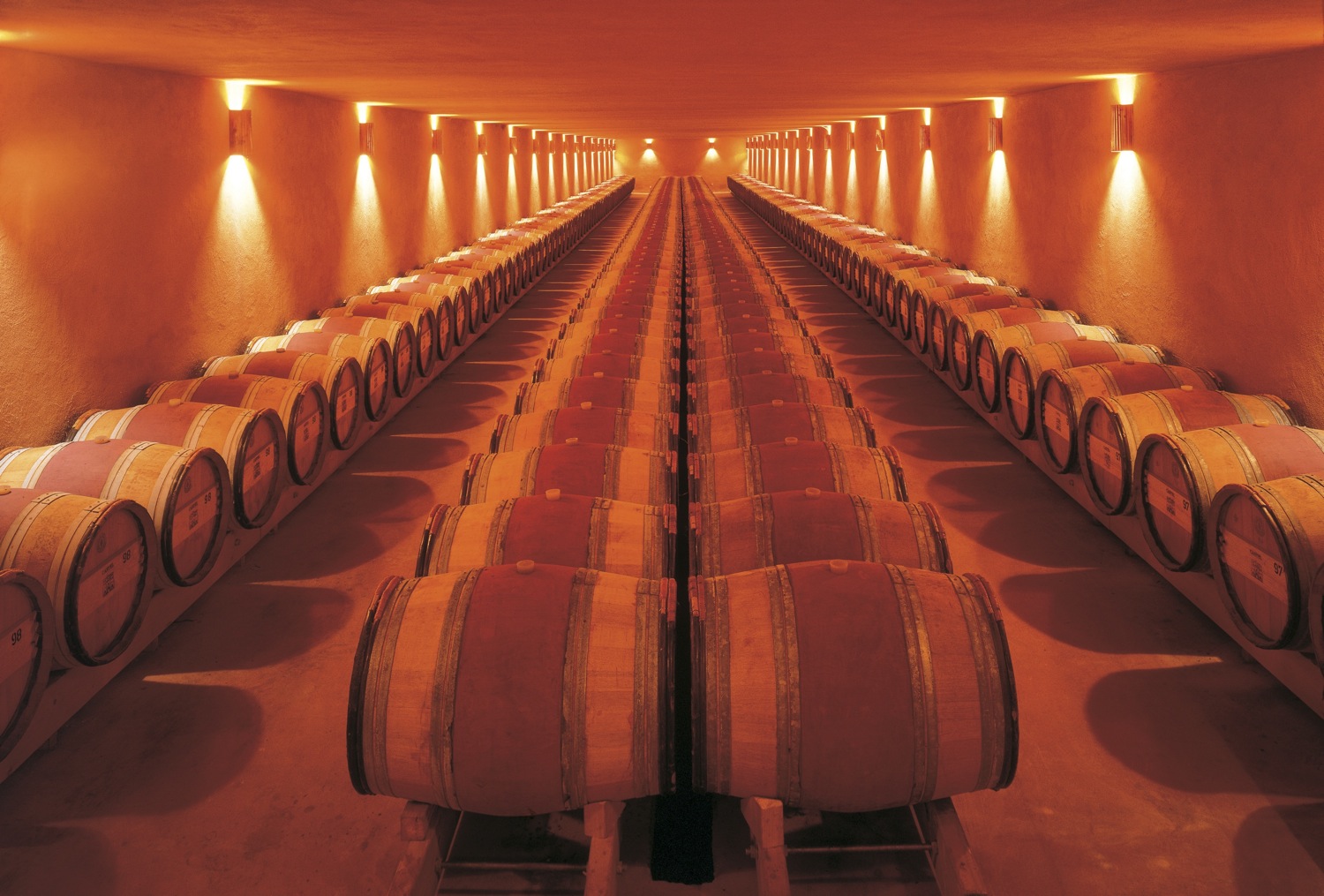
Of all the varietals I tasted, I think syrah/shiraz has the brightest future in Israel, especially a 2009 Domaine Netofa ($21) from Lower Galilee, a well-wrought Rhone-style red with some mourvedre in it. And if you like your wines plummy, the 2005 Yarden Syrah ($25) with 14.5 percent alcohol is a dead ringer for some of the bolder Australian Shirazes.
Focus
and
breeding will come with time, but the
ancient proverb of Ecclesiastes 9:7 seems truer than ever
during the
holidays, “Eat thy bread with joy,
and drink thy
wine with a merry heart; for God now accepteth thy works.”
John
Mariani's wine column appears in Bloomberg Muse News,
from
which
this
story was adapted. Bloomberg News covers Culture from art,
books,
and theater to wine, travel, and food on a daily basis.
~~~~~~~~~~~~~~~~~~~~~~~~~~~~~~~~~~~~~~
 HOLY PEPPERONI!
HOLY PEPPERONI!
At a Pizza Lounge in Dallas, a 61-year-old man tried to buy
a meal with a stolen credit card,
prompting an employee who said he was "sick and tired of this type of
thing" and proceeded to take the man outside, made him strip naked, and
beat him with a pipe.
OLD
BUDDHIST PROVERB SAYS, "SHUT UP AND
GO SLICE SOME FISH!"
"Sushi-bar-and-open-mind: This is the way to happiness and
enlightenment. The Buddhist concept upaya
prescribes the right teaching for the right student at the right time.
Through upaya, the skillful teacher offers not only salvation from
ignorance, but movement toward understanding beyond the mere
intellectual: understanding of the connection of all things great and
small. . . . Sushi Kappo Tamura owner/sushi chef Taichi Kitamura used
to own a Chiso Kappo upstairs, [but] Kitamura didn't seem
comfortable talking about his food then, even when asked. Once he
memorably told a captive audience that his parents never told him they
loved him."--Bethany Jean Clement, "Sushi Kappa Tamura," The Stranger (10/26/10).
`````````````````
QUICK BYTES
✉ Guidelines for submissions: QUICK BYTES publishes only events, special dinners, etc, open to the public, not restaurant openings or personnel changes. When submitting please send the most pertinent info, incl. tel # and site, in one short paragraph as simple e-mail text, WITH DATE LISTED FIRST, as below. Thanks. John Mariani
* On Dec. 4
in Scottsdale, AZ, Sassi will host a holiday
cooking class by Executive Chef Christopher Nicosia.
Personalized instruction on antipasti ideal for holiday parties,
Sassi's
signature handmade orecchiette pasta and chocolate and espresso custard
with
ricotta fritters; $65 pp, inc. lunch, wine pairings and recipes;
visit sassi.biz
or call 480-502-9095.
* On Dec. 16 in Louisville, Ky, The Brown Hotel presents a holiday season dinner featuring the sparkling wines of Mumms. Guests will dine on seasonally inspired food prepared by executive chef Laurent Géroli paired with a variety of sparkling wines. Holiday music will round out this delightful and festive evening. $79 pp. Call 502-736-2998.
*
On
Dec.
18, La Quinta Resort &
Club in Palm Springs, CA
will host
“Delicious Holiday Soup & Homemade Hot Chocolate” Interactive Demo.
Participants will sip La Quinta Nectar and given tastes and recipes. $12 pp ($5 for resort members
and complimentary for resort guests). Call 760-564-4111 x 7259.
* On Dec. 18 – Dec. 21, The Grand Del Mar in San Diego, CA will host the 2nd Annual Nutcracker Holiday Tea in the Elizabeth Ballroom, with a 2- course family service of tea sandwiches and French pastries, followed by a kid-friendly 45 min. performance of “The Nutcracker Suite.” $48 pp. Call 858-314-1988.
* On Dec. 19, Ouray, Colo., will host the “Third Annual Festivus Block Party” modeled after the classic “Seinfeld” television episode. Ouray’s Festivus features food and beverage vendors, “Feats of Strength,” a “Burn Barrel of Grievances,” and the unadorned aluminum “Festivus Pole.” Free to attend. Visit ouraycolorado.com or call 970-325-4746.
~~~~~~~~~~~~~~~~~~~~~
Everett Potter's Travel Report:

~~~~~~~~~~~~~~~~~~~~~~~~~~~~~~~~~~~~~~~~~~~~~~~~~~~~~~~~~~~~~~~~~~~~~~~~~~
Eating Las Vegas is the new on-line site for Virtual Gourmet contributor John A. Curtas., who since 1995 has been commenting on the Las Vegas food scene and reviewing restaurants for Nevada Public Radio. He is also the restaurant critic for KLAS TV, Channel 8 in Las Vegas, and his past reviews can be accessed at KNPR.org. Click on the logo below to go directly to his site.
~~~~~~~~~~~~~~~~~~~~~~~~~~~~~~~~~~~~~~~~~~~~~~~~~~~~~~~~~~~~~~~~~~~~~~~~~~~
Tennis Resorts Online: A Critical Guide to the World's Best Tennis Resorts and Tennis Camps, published by ROGER COX, who has spent more than two decades writing about tennis travel, including a 17-year stretch for Tennis magazine. He has also written for Arthur Frommer's Budget Travel, New York Magazine, Travel & Leisure, Esquire, Money, USTA Magazine, Men's Journal, and The Robb Report. He has authored two books-The World's Best Tennis Vacations (Stephen Greene Press/Viking Penguin, 1990) and The Best Places to Stay in the Rockies (Houghton Mifflin, 1992 & 1994), and the Melbourne (Australia) chapter to the Wall Street Journal Business Guide to Cities of the Pacific Rim (Fodor's Travel Guides, 1991). THIS WEEK:

Family Travel
Forum: The
Family
Travel
Forum
(FTF),
whose
motto
is
"Have
Kids,
Still
Travel!",
is
dedicated
to
the
ideals,
promotion
and
support
of
travel
with
children.
Founded
by business professionals John Manton and Kyle
McCarthy with first class travel industry credentials and global family
travel experience, the independent, family-supported FTF will provide
its members with honest, unbiased information, informed advice and
practical tips; all designed to make traveling a rewarding, healthy,
safe, better value and hassle-free experience for adults and children
who journey together. Membership in FTF will lead you to new worlds of
adventure, fun and learning. Join the movement.
All You Need to Know Before You Go
nickonwine: An engaging, interactive wine column by Nick Passmore, Artisanal Editor, Four Seasons Magazine; Wine Columnist, BusinessWeek.com; nick@nickonwine.com; www.nickonwine.com.

MARIANI'S VIRTUAL GOURMET NEWSLETTER is published weekly. Editor/Publisher: John Mariani.
Contributing Writers: Christopher
Mariani, Robert Mariani,
John A. Curtas, Edward Brivio, Mort
Hochstein, Suzanne Wright, and
Brian Freedman. Contributing
Photographers: Galina Stepanoff-Dargery, Bobby Pirillo. Technical
Advisor:
Gerry McLoughlin.
Any of John Mariani's books below
may be ordered from amazon.com by clicking on the cover image.
 My
newest book, written with my brother Robert Mariani, is a memoir of our
years growing up in the My
newest book, written with my brother Robert Mariani, is a memoir of our
years growing up in the For those of you who don't think of the Robert and I think you'll enjoy this very personal look at our --John Mariani |
 |
 |
 |
 |
 |
 |
© copyright John Mariani 2010
